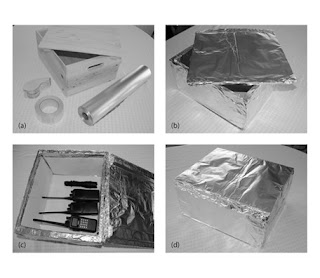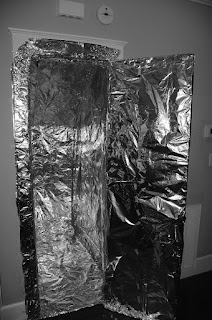
In the first part, we studied the characteristics of an EMI – Electromagnetic Pulse – causes and probabilities.
We have seen that for the prepper, such a threat must be taken seriously, whatever its natural or human origin. All the more so, unlike others such as nuclear, for example, that there are a number of easy and affordable solutions to protect themselves.
They consist mainly for the installation of Faraday cages intended to receive sensitive equipment …
The principle of the Faraday cage
This device takes its name from its inventor, Michael Faraday, and originally consisted of a conductive aluminum enclosure connected to earth in order to maintain its fixed potential, which is tight to electric fields, whether or not created by a current.
There are different types of cages, which can be adapted according to needs:
– Modular cages
These are a priori those most suited to the prepper, and the easiest to achieve. They are made from folded steel bins or wooden panels coated on both sides with a sheet of steel. The bins are assembled together using bolts. The wood panels are assembled using steel joining profiles.
The modular cages, Achieve performance exceeding 130 dB at 1 GHz.
– Architectural cages made of copper
These are made using a copper strip of 0.2 or 0.3 mm which is laid overlapping and brazed continuously with tin. This technique is used in large spaces and allows to adapt to complex geometries (corners, recesses, beams, pillars). There is no loss of space, copper being applied directly to the walls.
Copper cages allow performance to exceed 120 dB at 1 GHz.
– Architectural cages made of metallic fabric
The cage is made using a metallic tapestry placed with glue. The achieved performances are greater than 60 dB at 100 MHz. This performance is sufficient for a few applications.
Some domestic appliances equipped with internal shields could constitute a priori good Faraday cages. The best known are microwave ovens and refrigerators. It must be said that their reputation in this field is largely overrated, especially for the former, and such devices must be imperatively tested beforehand (see below).
In summary, a Faraday cage is a closed structure which has an outer conductive layer. It can take the form of a box, a cylinder, a sphere or any other form as long as it is closed. The outer layer can be conductive by itself (iron, aluminum, etc.) or made of a non-conductive material (wood, cardboard, polystyrene, etc.)

A Faraday cage made from a wooden box covered with layers of aluminum foil
The manufacture of a Faraday cage
Without going into too technical an explanation, we will only remember that it is not necessary for the outer metal layer to be very thick to protect against EMF. If you have chosen aluminum, a few layers of a slightly thicker aluminum kitchen sheet will do the trick.
It is always best to avoid “holes” and leaks in the structure, knowing that they will not compromise safety if their size remains tiny (pin holes or a few millimeters only). As for the metal used, it does not really matter. The conductivity of just about any metal is sufficient to thwart the effect of an EMI, although some are more conductive than others. For example, Silver (the best conductor) was used in place of aluminum, it would then suffice of a thickness 4 to 5 times less. Of course, it would be ridiculous to invest in silver containers when materials that do not cost anything do the trick!
Contrary to what can sometimes be read, experience has proved that it is not necessary to connect the cage to the ground once it is completed (the level of the electromagnetic field inside the box being Practically the same in both cases). It is also better not to bury it, which would mean focusing the IEM and increasing its power.
As can be deduced, there are many all-purpose containers that can be laid out in Faraday’s cage. The smaller ones could be ammunition metal crates, or galvanized steel buckets with a lid. See wooden boxes covered with aluminum. Personally, I recommend the iron canteens, which are found in multiple sizes.
Whatever the starting box you choose, it is imperative that it be completely covered with conductive metal, including the lid and especially the junction between this lid and the edges of the box . In image C of the picture above, you will notice that the edges of the sides were also covered with aluminum paper, as well as the underside of the lid. On the other hand, the same photo suggests that there would be only one aluminum thickness, which is largely insufficient.
Finally, another fundamental point is to insulate the interior so that none of the equipment to be protected can be in contact with the conductive metal . Such insulation may be made by means of polystyrene, wood, or cardboard sheets glued to the inside of the walls.
For those who have a lot of equipment, there is nothing to prevent the construction of large cages, or even to dedicate an entire room if necessary. As you know, it will be enough to cover the walls of the room with aluminum or copper foil, from floor to ceiling , without forgetting to isolate these sheets together and the last, in a way That nothing that can be put into the ”

A wardrobe in a Faraday cage. All that’s needed is to insulate the aluminum inside.
Safes are, of course, excellent Faraday cages, as are the majority of lifts (which is why notebook signals do not go through). Cars also, but to a much lesser extent since they contain many non-conductive composite materials as well as large glazed surfaces. The test is simple, if you can call or receive calls inside your car, it means ipso facto that it is not a Faraday cage!
Also Read: Prepper List 2022: Everything You Need To Survive
Finally, and contrary to legend, a microwave oven is not a good Faraday cage, nor are Mylar bags.
An easy method for an emergency cage would be to put the object to be protected in a somewhat thick plastic bag, Such as those used for freezing, and to wrap aluminum paper around it. For a really effective protection, experience has proved that the operation should be repeated no less than five times, ie put the object thus protected in another bag surrounded by another layer of d ‘Alu, and so on.
The principle is not much more complicated for a hard container, since it consists simply of “to make a box in the box”. For example, and for an iron canteen, this would amount to: Object thus protected in another bag surrounded by another layer of aluminum, and so on:
- Insulate the entire interior including the underside of the lid with thin polystyrene plates.
- Place a wire mesh on the sides and bottom, joining the different panels by welding or with wire, not forgetting the underside of the lid and the junction between the lid and the edges.
- Isolate this screen with other plates of polystyrene or wood, or cardboard, so that the contents of the box is not in contact with the metal.
- Test the cage when finished (see method below).
- Add one or two additional levels of protection if necessary by doubling or tripping the toasting layer. You could also use thick aluminum kitchen sheet glued to an insulating layer (minimum 3 layers).
What must be protected
The effects of an IEM attack on electronic systems will be largely related to its size and altitude. Some solar storms or low-power nuclear bombs would probably have little impact on earth, but in any case it would not cost the survivist a lot to take precautions by setting up appropriate cages.
A massive EMP attack such as that generated by an atomic bomb at high altitude exploding would result in “grill” the electrical and electronic systems of all kinds such as mobile phones, walkie talkies, radios, TVs, battery chargers – there Including solar – most recent LED lamps, night vision systems, Thermal imaging, computers, usb keys containing information, alarm systems, etc.
And, at the same time, to trigger electro-pyrotechnic firing systems , such as those of Claymore and other mine explosives, insofar as accidental ignition of an electro-pyrotechnic device can be caused by The electrical energy induced by a transmission system, an electromagnetic pulse or simply static electricity …
It is likely that the vast majority of cars continue to drive in the event of an EMI attack, but the latest models stuffed with d Could become unusable.
The good news is that simple pyrotechnic systems such as ammunition primers are not affected by an EMI, unless they can be stored in one place and in very large quantities. So no risks a priori to see his explosion in his hands!

How do you know if your Faraday cage is effective?
The frequencies of an IEM range from approximately those of an AM radio to those of an FM radio, that is to say from the frequencies 540 kHz to those of 108 MHz. Even if this does not tell you much, the important point to remember is that it is possible to test the efficiency of a Faraday cage using a simple AM / FM radio .
To start, chock your radio on the FM station that has the strongest reception signal, and turn the volume all the way. Put the radio in the cage you have set up, then close the lid. If you do not hear it, your cage will have blocked the signal. Do not rejoice too quickly either, Since the signals from the FM band are the easiest to stop.
Then set your radio to an AM station, and perform the same test. The low frequencies of the AM signals make the last ones able to penetrate the objects in depth. If you do not hear anything, it’s a good sign. Anything that is able to block strong FM and AM signals is likely to constitute a good Faraday cage .
Keep in mind, however, that the power of these signals is relatively low inside a house unless you live in close proximity to a relay antenna. It’s important to know, to the extent that you can see videos on YouTube and elsewhere where people put their mobile phone in a microwave oven or in a Mylar bag, And “prove” the effectiveness of such devices because they stop the signal. But notebook signals are the easiest to stop, and without commensurate with the power of those that an IEM would generate. Such equipment would have no chance of stopping the radiation from a massive electromagnetic pulse.
You can experience it for yourself. If you live near an antenna, and you put your AM radio in the microwave, it is likely that you can always hear it, proof that your oven is not a Faraday cage.
In the same way, you would realize that thick cooking aluminum foils are a very good insulator. If you decide not to ‘
- Use a minimum of 5 layers of aluminum foil, all insulated from each other.
- The sheet placed closest to the object should not be in direct contact with it, in which case it would amplify the signal by serving as an antenna.
- It is best to use the thickest sheets possible.
Also remember to remove all the batteries from your devices before storing them!
Of course, you do not have to pack each piece individually. You can for example put several in a cloth pouch, and surround the set of aluminum.
One last thing : In case of an IEM attack, do not be too hurried to open your cage and take out the material. A possible enemy could launch a first IEM attack, then wait a few days before launching a second attack in order to destroy as many equipment as possible.
The ideal would be to have two sets of equipment in two different Faraday cages . The first would be small with few things to do, Such as an AM / FM radio and a few walkie-talkies, and the second largest containing all the main equipment. The latter would then only be opened after a certain delay following an EMI attack, or when it would really be needed.
As you can see, protecting electronic equipment is not very difficult. By taking your precautions now, you can make sure they will still work the day the lights go out …
